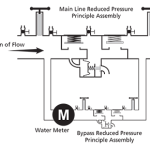
Backflow is the stuff of a public works director’s nightmares.
Seriously!
What is backflow?
Backflow is the worst case scenario unleashed on an unsuspecting public.
Can it happen?
It not only can happen, but it does happen, throughout the year in most major cities. Thankfully, though, we have the Clean Water Act of 1972 and we have backflow prevention procedures to protect us.
Let’s explain!
What is backflow?
To answer that question we need an understanding of how water arrives at your home or business. Clean water is sent from a city’s water supply to citizens by means of water pressure. Pressure is exerted into the water pipes at the Public Works facility, or the city’s reservoir. That pressure “pushes” water through the pipes to the many locations in the city which use water i.e. basically every residential home and every commercial and industrial location. All is well in the world as long as this system works flawlessly.
But what happens if there is a drop in water pressure at a spot in the system before your home or business? Let’s say there is a major fire, and four fire hydrants are opened at the same time. Or let’s say there is a puncture in a water main, resulting in major leakage. In those scenarios, the water pressure would plummet inside the pipes, and it is entirely possible that the pressure would drop so much that water would actually flow in the opposite direction, aka backflow. If that were to happen, polluted water would be flowing back into a city’s clean water supply.
A nightmare!
Can that scenario happen? It has in the past, and thus we now have backflow prevention measures we can take to prevent it from happening.
What backflow prevention measures?
The city planning department, in conjunction with the Public Works Department, decide which properties in a city are at high risk of backflow. Those properties must then have backflow devices installed at cross connection points in their water system.
What is a backflow device?
The most commonly used backflow device is a one-way valve. It is installed at cross-connection points in the water system, thus insuring that water will only flow in one direction. Those one way valves must be inspected yearly to make sure they are working properly.
Who do you call to find out your backflow liabilities?
Your Public Works Administration will be able to tell you if your property is require do have backflow devices. They can also give you a list of licensed and certified backflow inspectors who can do backflow inspections, backflow repairs, and backflow installations. Make sure you only use a contractor who is on that city’s approved list. Even though backflow is a plumbing problem, not every plumber is trained in backflow techniques.
Any questions? You can call us, City Backflow Testing, and we should have the answers you need. Our number is (817) 996-2000, and we serve the Greater Dallas/Fort Worth area. With decades of backflow experience, City Backflow Testing is the name you can trust for all things related to backflow.
Posted in Backflow Testing
Tagged backflow, backflow preventer, backflow testing, city backflow testing, what is backflow

